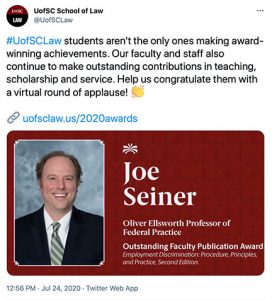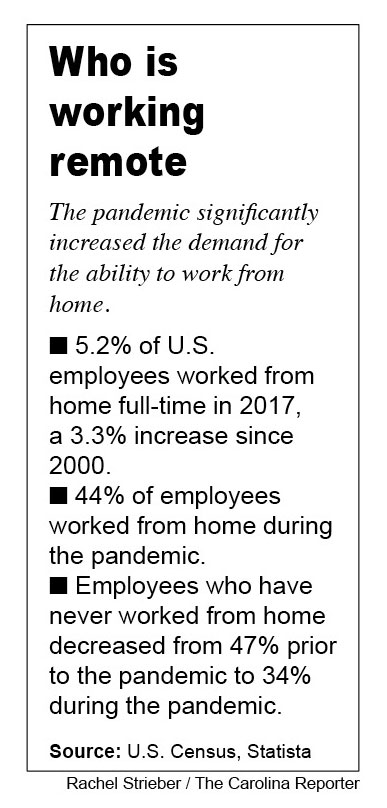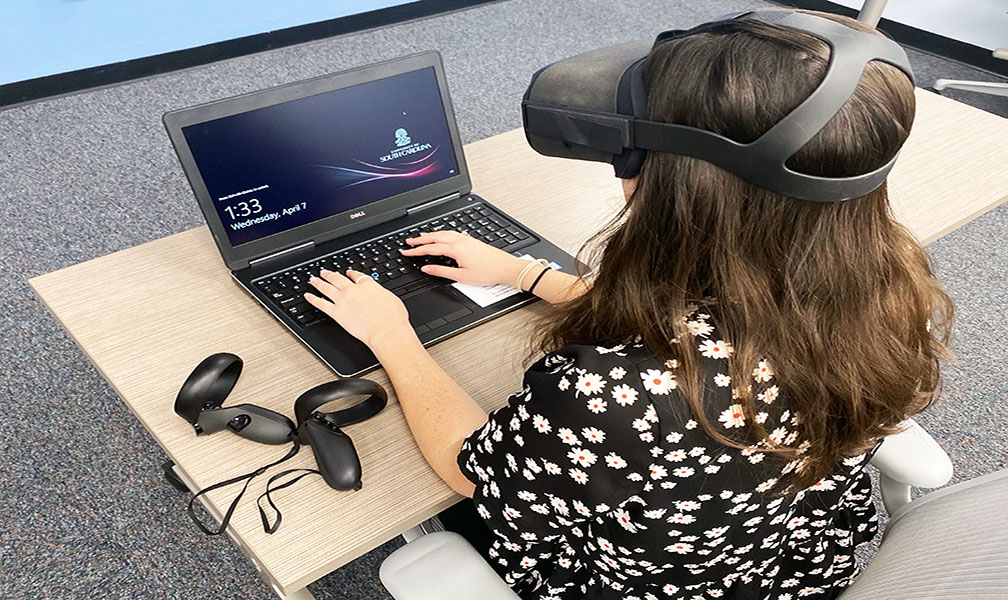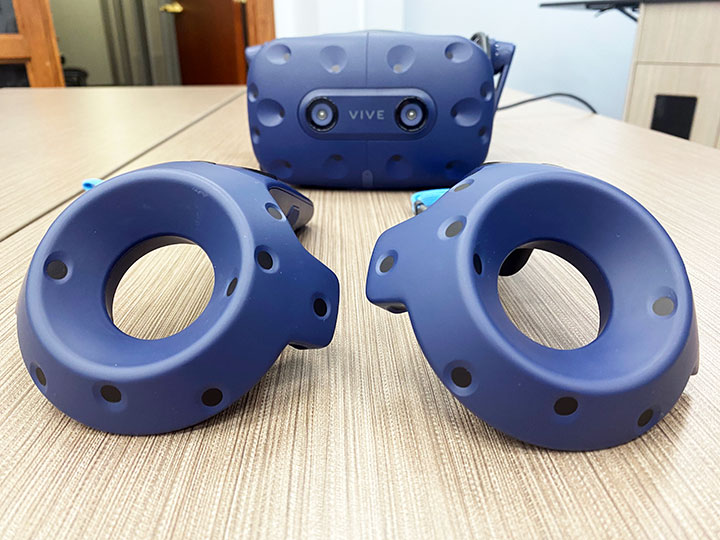Joseph Seiner, an author and University of South Carolina law professor, predicts much of the workforce will soon be conducted through virtual reality. He discusses how employment has changed in light of technology in his upcoming book. Photos by: Rachel Strieber
A lot has changed since Joseph Seiner, an author and University of South Carolina law professor, argued in court that some employees ought to be granted flexibility to work from home.
“Now, you’re almost at the inverse of that, where a lot of employers are requiring it and not allowing you to come into the workplace,” said Seiner.
Seiner has written a book about this changing workplace landscape. “The Virtual Workplace: Public Health, Efficiency, and Opportunity,” is available for pre-order on Amazon for $29.99 and will be released next month. It analyzes the future of the workforce and how employment has changed in light of technology and the pandemic.
In one of his most startling assessments, Seiner predicts much of the workforce will soon be conducted through virtual reality.
“The way we look at work five years from now is going to look nothing like it looks right now,” said Seiner. “Zoom five years from now is going to be a dinosaur.”
If Seiner could tell the readers of his new book one thing, it is that even when the pandemic ends, this technological change with working from home and remotely is here to stay, and it will continue to evolve.
“We’re going to be doing things like virtual reality, it’s right around the corner,” said Seiner. “They are fine tuning that, and I think we’re going to be – literally transported – into the virtual workplace.”
Seiner worked on this book for around three years and postponed its release for about a year to incorporate the pandemic into its research.
“It looks at the intersection between technology and the workplace,” said Seiner. “It uses the pandemic as a lens.”
The book also discusses concepts such as who counts as an employee.
“Is an Uber driver an employee, or is that an independent contractor?” Seiner asked. “How do platform-based workers like Instacart workers – if they want to have a class action claim, how do they do it? How do they organize in the workplace collectively?”
This is not Seiner’s first published book.
In 2019, he published “Employment Discrimination: Procedure, Principles & Practice,” a book about procedural problems and addressing discrimination in workplace legal cases. In 2020, UofSC School of Law recognized Seiner for his teaching career and this book, with the Outstanding Faculty Publication Award.

Photo courtesy: @UofSCLaw Twitter Account
Seiner, a native of Michigan, always knew he wanted to pursue law as a career path. He practiced around the country for almost 10 years before he started teaching at Georgetown University Law Center and then UofSC School of Law.
“I just really loved the teaching aspect way more than I thought I was going to,” said Seiner.
The legal field in particular has faced challenges regarding working and conducting trials throughout the pandemic.
More than 10 million people watched a Texas lawyer inform a judge, “I am not a cat,” when the lawyer could not remove a Zoom filter during a hearing in the 394th District Court of Texas.
Video courtesy: 394th District Court of Texas Live Stream YouTube Channel
While many found “Lawyer Cat” funny, others worried that more serious problems could arise from conducting the legal profession virtually.
“From a law standpoint, it’s a constitutional issue, and it’s a right to confrontation – a due process,” said Seiner. “You know, are you being heard? Are you confronting your witnesses… over a screen?”
Seiner said it’s important to follow the constitutional requirements in criminal cases, among others.
“Before you’re put in jail, you actually have an opportunity to confront your witnesses that are putting you or helping to put you there,” said Seiner.
The legal profession isn’t the only one experiencing problems working remotely.
“You’re going to see an uptick, at least until the technology does get better, on emotional and psychological problems [with remote working]… that will increase in the short term, because there is going to be a great sense of isolationism,” said Seiner.
Seiner encourages companies to use third-party programs, where employees can get access to mental health and are aware of those resources.
“So they can allow their workers to feel comfortable seeking out that type of guidance,” said Seiner. “When you’re talking about 40, 50, 60 hours per week working at home, you can rightly expect that that’s going to cause people – as they adjust to it and as the technology adjusts to it – different stressors.”
Despite the many challenges working from home can bring, Seiner thinks it’s here to stay.
“Over the last 18 months, we’ve seen a tremendous takeoff in technology, how the technology works… the way we support that technology,” said Seiner. “Going forward, in the next year or two, we’re going to see the technology get even far more advanced than what it is now – far more improved.”
Seiner encourages employees, who will remain working from home even after the pandemic, to treat the situation as an opportunity.
“‘Pick your avatar today,’” said Seiner. “That’s really where this is heading… and people need to accept that this isn’t going to go back to how it was. This is really going to take off into a whole different technological direction.”
Children of the pandemic may not be familiar with anything other than working remotely by the time they start their careers.
“I have two kids – 9 and 11 – and they really inspire me…” said Seiner. “I think, ‘What is the working world going to look like when they’re getting out of college, or law or medical school?’”
Seiner’s inspiration for his career and the book stems from his background. His dad worked for General Motors for 42 years in Flint, Michigan.
“So, I always saw, growing up, a lot of the different labor issues and workplace issues that came up from day to day,” said Seiner. “I always thought it was a fascinating topic, particularly because it’s one that has such a human element to it… it’s really very emotionally charged.”
While some think labor, employment, and corporate law can be dry professions, Seiner argues otherwise.
“You will have people yelling in your office and crying in your office, and you see the entire spectrum of human emotion,” said Seiner. “Because there is really nothing… that we associate our identities with as closely as what we do for a living – what our job is.”
Virtual reality equipment is quickly advancing, and Seiner believes technology will continue to evolve until employees are literally “transported” into the virtual workplace.

Seiner, a Michigan native, practiced law for almost 10 years before he started teaching about labor law and employment discrimination at Georgetown University Law Center and then University of South Carolina School of Law. Photo courtesy: University of South Carolina School of Law
“The Virtual Workplace: Public Health, Efficiency, and Opportunity” will be Seiner’s fourth published book. It will be released next month and discusses the future of the remote workforce.
In 2020, University of South Carolina School of Law recognized Seiner with the Outstanding Faculty Publication Award, to honor his teaching career and another one of his published books, “Employment Discrimination: Procedure, Principles & Practice.”






